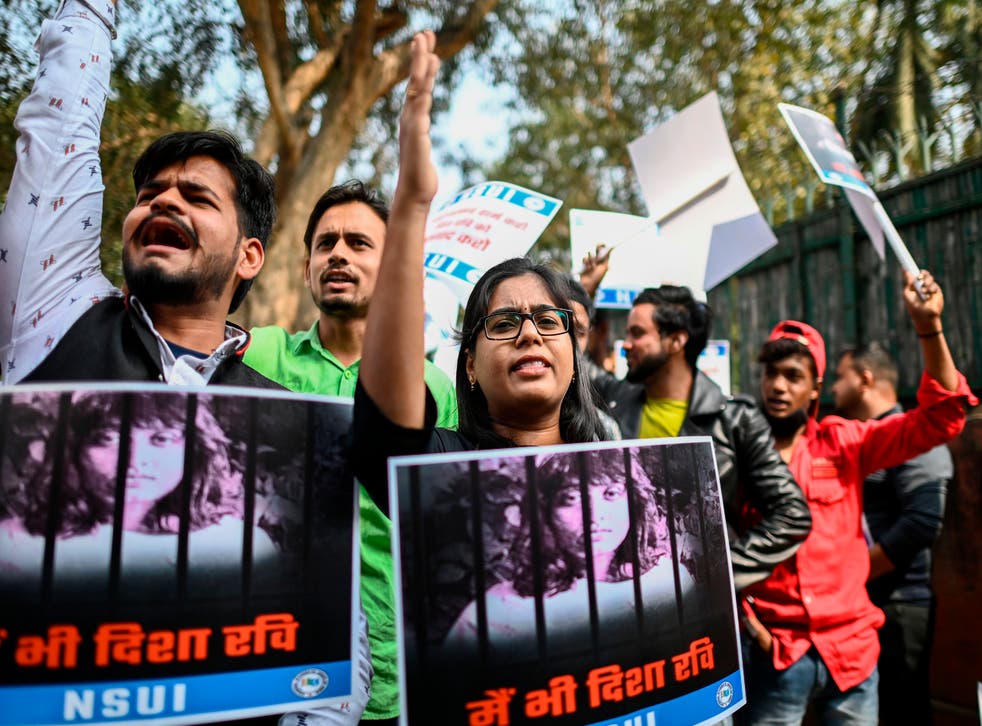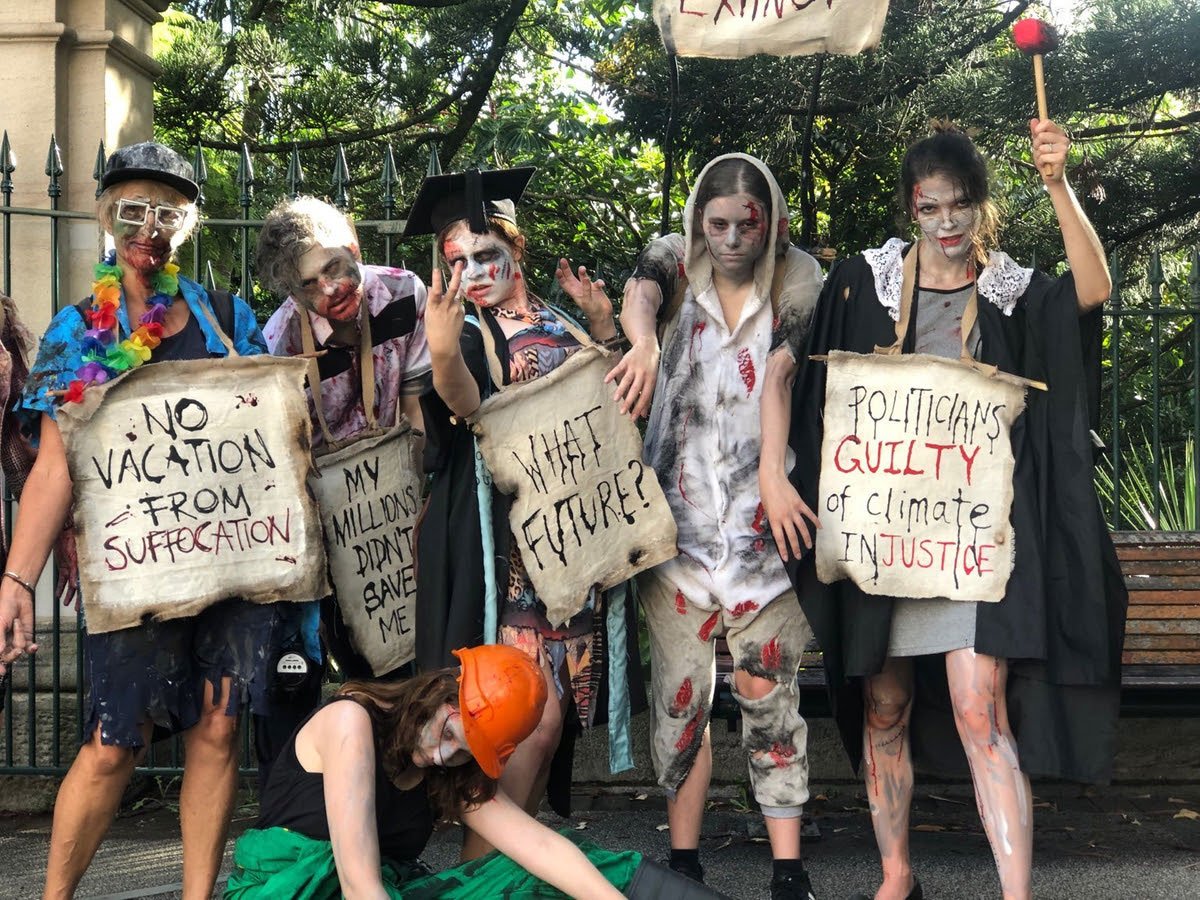The arrest of a 22-year-old climate activist in India is an example of the disturbing use of legal power to clamp down on dissent in the world’s largest democracy, write Joanna Slater and Niha Masih

Ms Ravi was arrested by Delhi police for her alleged involvement in the instigation of violence during the farmers protest on 26 January, India’s Republic Day
(AFP/Getty)
As public enemies go, Disha Ravi is an unlikely candidate. The 22-year-old climate change activist works for a vegan food company and likes to join volunteer clean-up drives. Earlier this month, she helped disseminate a list of peaceful ways to support a major protest by farmers against new agricultural laws.
In today’s India, that was enough to make her a target. Over the weekend, Ravi was arrested. Police accused of her of sedition and conspiring to “spread disaffection” against the state.
Ravi’s arrest is the latest example of a disturbing trend in the world’s largest democracy. The government of Prime Minister Narendra Modi is deploying the country’s legal machinery to suppress opponents in a clampdown on dissent not seen in decades, critics say.
Read more

India police arrest climate activist linked to Greta Thunberg movement over protests ‘toolkit’
Modi won a landslide re-election victory in 2019 that made him the most powerful Indian leader since the 1970s. But the country's independent institutions – including the judiciary and the media – have rarely appeared weaker, experts say. Researchers who study democracy around the globe recently put India among a group of nations heading towards autocracy.
Freedom of expression is being curtailed. A comedian was recently kept in jail for more than a month for a joke he did not tell as judges repeatedly denied him bail. The use of internet shutdowns to quell protests and disrupt communication has soared under the Modi government. (India now uses the tactic more than any other country, according to Access Now, an international advocacy group that tracks such suspensions.) The Indian government this month ordered Twitter to block hundreds of accounts linked to the farmer protests.
The filing of sedition cases against people who criticise politicians or governments has also jumped, shows a recent analysis by Article 14, a research and reporting website focused on democratic rights. More than 95 per cent of such sedition cases over the past decade were registered after Modi came to power, it found.
Members of the ruling Hindu nationalist Bharatiya Janata Party reject any suggestion that there is a crackdown on dissent. “India is the largest democracy that humankind has ever seen, with an independent judiciary that routinely rules against the government and free media that daily provides a platform to the government's vocal critics,” says Baijayant Panda, national vice president of the BJP. “These allegations are instigated by the losers of elections in order to try and maintain their own relevance.”
Experts say previous Indian governments also targeted their opponents with politically motivated charges. But some warn that what is currently unfolding goes much further and even see parallels to an infamous period in the country's history known as the Emergency, when the then prime minister Indira Gandhi ruled by decree and suspended civil liberties
“It's a kind of smarter Emergency,” says Pratap Bhanu Mehta, one of India’s leading political scientists. There are no mass arrests of Indian politicians, as the country saw in 1975, but the ruling party has a “creeping stranglehold over all institutions” while opposition parties are weak, Mehta says. “In some sense, I think it’s much more insidious.”
Since November, tens of thousands of farmers have blocked roads in opposition to major changes to agricultural policy
Government pressure on journalists has intensified, and the mainstream media seldom criticises the government. Key agencies are headed by personnel considered loyal to Modi. India’s Supreme Court has delayed rulings on the constitutionality of major government policies, including changes to the status of Kashmir, an overhaul of campaign finance laws and a new pathway to citizenship that some believe undermines India’s secular foundations.
Modi won a landslide re-election victory in 2019 that made him the most powerful Indian leader since the 1970s. But the country's independent institutions – including the judiciary and the media – have rarely appeared weaker, experts say. Researchers who study democracy around the globe recently put India among a group of nations heading towards autocracy.
Freedom of expression is being curtailed. A comedian was recently kept in jail for more than a month for a joke he did not tell as judges repeatedly denied him bail. The use of internet shutdowns to quell protests and disrupt communication has soared under the Modi government. (India now uses the tactic more than any other country, according to Access Now, an international advocacy group that tracks such suspensions.) The Indian government this month ordered Twitter to block hundreds of accounts linked to the farmer protests.
The filing of sedition cases against people who criticise politicians or governments has also jumped, shows a recent analysis by Article 14, a research and reporting website focused on democratic rights. More than 95 per cent of such sedition cases over the past decade were registered after Modi came to power, it found.
Members of the ruling Hindu nationalist Bharatiya Janata Party reject any suggestion that there is a crackdown on dissent. “India is the largest democracy that humankind has ever seen, with an independent judiciary that routinely rules against the government and free media that daily provides a platform to the government's vocal critics,” says Baijayant Panda, national vice president of the BJP. “These allegations are instigated by the losers of elections in order to try and maintain their own relevance.”
Experts say previous Indian governments also targeted their opponents with politically motivated charges. But some warn that what is currently unfolding goes much further and even see parallels to an infamous period in the country's history known as the Emergency, when the then prime minister Indira Gandhi ruled by decree and suspended civil liberties
“It's a kind of smarter Emergency,” says Pratap Bhanu Mehta, one of India’s leading political scientists. There are no mass arrests of Indian politicians, as the country saw in 1975, but the ruling party has a “creeping stranglehold over all institutions” while opposition parties are weak, Mehta says. “In some sense, I think it’s much more insidious.”
Since November, tens of thousands of farmers have blocked roads in opposition to major changes to agricultural policy
Government pressure on journalists has intensified, and the mainstream media seldom criticises the government. Key agencies are headed by personnel considered loyal to Modi. India’s Supreme Court has delayed rulings on the constitutionality of major government policies, including changes to the status of Kashmir, an overhaul of campaign finance laws and a new pathway to citizenship that some believe undermines India’s secular foundations.
Tarunabh Khaitan, vice dean of the faculty of law at Oxford University, recently wrote a paper describing how India’s constitution is under assault from “a thousand cuts.” India risks becoming a democracy in name only, he said, one where elections continue but the opposition has little chance of taking power.
“We are at the precipice,” Khaitan said in an interview. “Do we jump, or can we slowly, cautiously walk back?
”
Activists from the National Students' Union of India (NSUI) protest against the arrest of Disha Ravi during a demonstration in New Delhi, on 17 February 2021
(AFP/Getty)
One case that is considered a harbinger for where India is headed began in 2018. More than a dozen activists were arrested and accused of plotting to overthrow the government, charges they denied. All of the activists worked with India’s most disadvantaged communities, including tribal people and Dalits, and were vocal critics of Modi and his party.
Last week, an analysis by a digital forensics firm in the United States concluded that key electronic evidence in the case was planted on a laptop by a hacker using malware. The findings of the forensic report help bolster long-held claims by human rights groups and legal experts that the case was unfounded. Defence lawyers have asked judges to dismiss the case against the activists, although it is unclear when the court will rule.
Students, activists, journalists and nongovernmental organisations are among those who have come under increasing pressure from the authorities. In Kashmir, the government engaged in a months-long crackdown, snapping communications and detaining mainstream politicians. Elsewhere in India, when anti-government protests break out, law enforcement authorities repeatedly find alleged conspiracies – and arrests follow.
In December 2019, protests erupted across the country in response to a new citizenship law that critics say discriminates against Muslims. Dozens of people were killed in Uttar Pradesh, India’s largest state, in the ensuing crackdown. In February, riots broke out in Delhi that left more than 50 people dead, most of them Muslim

Activists from the National Students' Union of India (NSUI) protest against the arrest of Disha Ravi during a demonstration in New Delhi, on 17 February 2021
(AFP/Getty)
One case that is considered a harbinger for where India is headed began in 2018. More than a dozen activists were arrested and accused of plotting to overthrow the government, charges they denied. All of the activists worked with India’s most disadvantaged communities, including tribal people and Dalits, and were vocal critics of Modi and his party.
Last week, an analysis by a digital forensics firm in the United States concluded that key electronic evidence in the case was planted on a laptop by a hacker using malware. The findings of the forensic report help bolster long-held claims by human rights groups and legal experts that the case was unfounded. Defence lawyers have asked judges to dismiss the case against the activists, although it is unclear when the court will rule.
Students, activists, journalists and nongovernmental organisations are among those who have come under increasing pressure from the authorities. In Kashmir, the government engaged in a months-long crackdown, snapping communications and detaining mainstream politicians. Elsewhere in India, when anti-government protests break out, law enforcement authorities repeatedly find alleged conspiracies – and arrests follow.
In December 2019, protests erupted across the country in response to a new citizenship law that critics say discriminates against Muslims. Dozens of people were killed in Uttar Pradesh, India’s largest state, in the ensuing crackdown. In February, riots broke out in Delhi that left more than 50 people dead, most of them Muslim
.
‘If you ask difficult questions or decide to do something for a good cause, you can be sent to jail’
(AFP/Getty)
In the aftermath, the police charged Muslim students and activists who engaged in protests against the citizenship law with conspiracy to commit violence. Among those arrested were a pregnant graduate student who created a WhatsApp group to coordinate protests, an activist who ran a collective to foster interreligious unity and members of a student group working for women’s rights in university settings.
Harsh Mander, 65, is one of the country's most well-known activists who has worked for years on social justice causes, including efforts to bridge divides between Hindus and Muslims. His name has been mentioned in more than a dozen charging documents connected to the Delhi riots, he says, suggesting he could be arrested at any time as part of the alleged conspiracy.
“It’s like a dagger hung over you,” Mander says. “The hope and expectation is that we would be silent.”
The government’s response to farmer protests outside Delhi is the latest litmus test. Since November, tens of thousands of farmers have blocked roads in opposition to major changes to agricultural policy. While Modi has praised farmers, he has insisted the protesters are being misled. He recently told parliament that the country was facing a class of professional agitators, whom he called “parasites”, and warned of the need to protect the nation from “foreign destructive ideology”.
Two other Indian environmental activists with the climate change group Extinction Rebellion are already facing arrest
On 26 January, clashes broke out between farmers and police officers. Authorities shut down the internet at the protest sites and made dozens of arrests. Police later connected the violence to a “toolkit” tweeted by Swedish climate change activist Greta Thunberg, without citing evidence and despite the fact that the document lists only peaceful modes of protest.
(A toolkit is a document created to explain any issue on the social media. It also provides information on what a person must do to address the particular issue, which could include information on petitions, details about protests and mass movements.)
The police alleged that an organisation linked to the document – the nonprofit Poetic Justice Foundation, based in Canada – had promoted a separatist movement in the state of Punjab.
Ravi, the 22-year-old environmental activist, belonged to a group of young people around the world who joined Thunberg’s Fridays for Future environmental movement. She completed a degree in business administration at a prestigious university in Bangalore.
“Countries like India are already experiencing a climate crisis,” she said in an interview with The Guardian last year. “We’re not just fighting for our future, we are fighting for our present.”

Police detain an activist during a protest against the arrest of Disha Ravi in New Delhi, on 17 February 2021
(AFP/Getty)
Friends describe Ravi as a hard-working young woman with a slightly goofy side who is the only breadwinner in her family. She is passionate about animals and the environment, says Yuvan Aves, 25, a fellow volunteer in the Indian chapter of Fridays for Future. The message from Ravi's arrest is, “if you ask difficult questions or decide to do something for a good cause, you can be sent to jail,” he says. “For something as harmless as a toolkit.”
On 14 February, Ravi reportedly told a judge in Delhi that she had made minor edits to the toolkit document but did not write it. “We wanted to support the farmers,” she said in court, according to New Delhi Television, briefly breaking down in tears. A lawyer for Ravi declined to comment.
Justice Deepak Gupta, who retired from India’s Supreme Court last year, says the contents of the toolkit that are in the public domain are “not seditious in any manner”. The use of sedition cases in recent years is “a straight-up attempt to stifle the voices of dissent”, he says.
The government has also demanded that Twitter take down hundreds of accounts linked to the farmer protests. The social media company blocked many of the accounts but refused to do the same for handles belonging to journalists, media outlets, politicians and activists, saying it did not believe the “actions we have been directed to take are consistent with Indian law”.
Meanwhile, police in Delhi say their investigation of the toolkit will continue. Two other Indian environmental activists with the climate change group Extinction Rebellion are already facing arrest in the probe. Prem Nath, a senior police official in Delhi, told reporters last week that the activists’ intent was “to propagate the toolkit worldwide”, spur protests at Indian embassies and “tarnish India’s image”.

‘If you ask difficult questions or decide to do something for a good cause, you can be sent to jail’
(AFP/Getty)
In the aftermath, the police charged Muslim students and activists who engaged in protests against the citizenship law with conspiracy to commit violence. Among those arrested were a pregnant graduate student who created a WhatsApp group to coordinate protests, an activist who ran a collective to foster interreligious unity and members of a student group working for women’s rights in university settings.
Harsh Mander, 65, is one of the country's most well-known activists who has worked for years on social justice causes, including efforts to bridge divides between Hindus and Muslims. His name has been mentioned in more than a dozen charging documents connected to the Delhi riots, he says, suggesting he could be arrested at any time as part of the alleged conspiracy.
“It’s like a dagger hung over you,” Mander says. “The hope and expectation is that we would be silent.”
The government’s response to farmer protests outside Delhi is the latest litmus test. Since November, tens of thousands of farmers have blocked roads in opposition to major changes to agricultural policy. While Modi has praised farmers, he has insisted the protesters are being misled. He recently told parliament that the country was facing a class of professional agitators, whom he called “parasites”, and warned of the need to protect the nation from “foreign destructive ideology”.
Two other Indian environmental activists with the climate change group Extinction Rebellion are already facing arrest
On 26 January, clashes broke out between farmers and police officers. Authorities shut down the internet at the protest sites and made dozens of arrests. Police later connected the violence to a “toolkit” tweeted by Swedish climate change activist Greta Thunberg, without citing evidence and despite the fact that the document lists only peaceful modes of protest.
(A toolkit is a document created to explain any issue on the social media. It also provides information on what a person must do to address the particular issue, which could include information on petitions, details about protests and mass movements.)
The police alleged that an organisation linked to the document – the nonprofit Poetic Justice Foundation, based in Canada – had promoted a separatist movement in the state of Punjab.
Ravi, the 22-year-old environmental activist, belonged to a group of young people around the world who joined Thunberg’s Fridays for Future environmental movement. She completed a degree in business administration at a prestigious university in Bangalore.
“Countries like India are already experiencing a climate crisis,” she said in an interview with The Guardian last year. “We’re not just fighting for our future, we are fighting for our present.”

Police detain an activist during a protest against the arrest of Disha Ravi in New Delhi, on 17 February 2021
(AFP/Getty)
Friends describe Ravi as a hard-working young woman with a slightly goofy side who is the only breadwinner in her family. She is passionate about animals and the environment, says Yuvan Aves, 25, a fellow volunteer in the Indian chapter of Fridays for Future. The message from Ravi's arrest is, “if you ask difficult questions or decide to do something for a good cause, you can be sent to jail,” he says. “For something as harmless as a toolkit.”
On 14 February, Ravi reportedly told a judge in Delhi that she had made minor edits to the toolkit document but did not write it. “We wanted to support the farmers,” she said in court, according to New Delhi Television, briefly breaking down in tears. A lawyer for Ravi declined to comment.
Justice Deepak Gupta, who retired from India’s Supreme Court last year, says the contents of the toolkit that are in the public domain are “not seditious in any manner”. The use of sedition cases in recent years is “a straight-up attempt to stifle the voices of dissent”, he says.
The government has also demanded that Twitter take down hundreds of accounts linked to the farmer protests. The social media company blocked many of the accounts but refused to do the same for handles belonging to journalists, media outlets, politicians and activists, saying it did not believe the “actions we have been directed to take are consistent with Indian law”.
Meanwhile, police in Delhi say their investigation of the toolkit will continue. Two other Indian environmental activists with the climate change group Extinction Rebellion are already facing arrest in the probe. Prem Nath, a senior police official in Delhi, told reporters last week that the activists’ intent was “to propagate the toolkit worldwide”, spur protests at Indian embassies and “tarnish India’s image”.















